The Germans REALLY understood how to make / reinforce concrete. During the war, the Allies bombed the Keroman u-boat base in Lorient mercilessly but could never breach it. After the war, the French government wanted to destroy it but after a few months of trying, determined it wasn't worth the effort and instead repurposed it. It's still there today - I toured it a couple of years ago.The bunker has been hit, but I'm not sure even that damage (which is extensive) breached the bunker.
75th anniversary of D-Day...
- Thread starter crimsonaudio
- Start date
- Status
- Not open for further replies.
The "dragon's teeth" tank traps of the Siegfried Line (Westwand" are still in place for the same reasons...The Germans REALLY understood how to make / reinforce concrete. During the war, the Allies bombed the Keroman u-boat base in Lorient mercilessly but could never breach it. After the war, the French government wanted to destroy it but after a few months of trying, determined it wasn't worth the effort and instead repurposed it. It's still there today - I toured it a couple of years ago.
November 15, 1944: In Hurtgen, the Allied forces prepare for Operation Queen, desperately hoping the weather clears allowing the planned bombing raids before tomorrow’s ‘go’ date.
________
1st Battalion 22nd Infantry: Regimental Situation, 15 November
The day by day postponement of the attack from 11 November through 15 November provided the regiment with valuable time for preparation for the attack.
All company grade officers received additional instruction in the conduct of woods fighting and adjustment or artillery fire.
In anticipation of serious communications problems during the attack, plans were made to augment the normal communications system. A surplus of wire and radio equipment was obtained, communications personnel within the rifle battalions was increased, and plans were made to provide double wire lines to all battalions during the attack.
Evacuation difficulties were also expected. To take care of this problem, extra litter squads were organized. Plans were made to use “Weasels” (Carrier, cargo, M-29) to evacuate wounded from areas impassable to the 1/4 ton truck, which proved unable to operate in deep mud. The weasels were not effective since logs, stumps, and rots caused them to throw their tracks very frequently.
All 81-mm mortars of the regiment were massed and placed so as to be capable of supporting any unit of the regiment. Wire communication was maintained between each battalion and the mortar position.
The regiment was supported by the 44th FA Battalion (105-mm Howitzers), which was reinforced by the fires of the 20th FA Battalion (155-mm Howitzers). Attached to the regiment were the medium tanks or Co. C, 70th Tank Battalion; one platoon or light tanks from Co. D, 70th Tank Battalion; Co. C; 87th Cml Battalion (less one platoon); one platoon Co. C, 803rd Tank Destroyer Battalion (SP); one platoon Co. C, 4th Engineer (c) Battalion; and Co. C, 4th Medical Battalion. Tanks and tank destroyers were initially held in reserve, as the rough terrain and dense woods were not suitable for their effective employment.
The regiment planned to attack initially in a column of battalions, in the order 2nd, 1st, and 3rd.
________
British 2nd Army iattacks toward Zig Canal and US 3rd Army continues attacking all around Metz, to the south of the city, the Metz-Sarrebourg rail line is cut. US 7th Army continues advancing along the line north of St. Die and attacking around Avricourt, Halloville, Ancerville, and Raon-l'Etape while the French 1st Army attacks in the area around Le Tholy, Arcey, Hericourt, Colombier-Fontaine, Ecot, and Ecurcey. US 9th Air Force conducts limited operations due to poor weather conditions.
Over Germany, US 15th Air Force attacks Linz, Innsbruck, and other targets, RAF Bomber Command sends 177 aircraft to attack Dortmund during the day and 36 aircraft to attack Berlin overnight.
On the eastern front, the Soviet 2nd Ukrainian Front continues attacking around Budapest and trying to push across the Danube immediately to the south.
In Italy, US 5th Army captures Modigliana.
Pictured: Members of Anti-Tank Company, 22nd Infantry November 1944 in the Hurtgen Forest.; The cold hard wet slog continues across Holland for infantry and carriers of the 15th (Scottish) Division, November 15, 1944.; Situation map from November 15, 1944. Select Options -> Download for hi-res view.; Two King Tiger Tanks of the schwere Panzer-Abteilung 503 in the vicinity of Gyöngyösi, Hungary, on November 15, 1944.

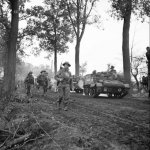
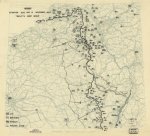

________
1st Battalion 22nd Infantry: Regimental Situation, 15 November
The day by day postponement of the attack from 11 November through 15 November provided the regiment with valuable time for preparation for the attack.
All company grade officers received additional instruction in the conduct of woods fighting and adjustment or artillery fire.
In anticipation of serious communications problems during the attack, plans were made to augment the normal communications system. A surplus of wire and radio equipment was obtained, communications personnel within the rifle battalions was increased, and plans were made to provide double wire lines to all battalions during the attack.
Evacuation difficulties were also expected. To take care of this problem, extra litter squads were organized. Plans were made to use “Weasels” (Carrier, cargo, M-29) to evacuate wounded from areas impassable to the 1/4 ton truck, which proved unable to operate in deep mud. The weasels were not effective since logs, stumps, and rots caused them to throw their tracks very frequently.
All 81-mm mortars of the regiment were massed and placed so as to be capable of supporting any unit of the regiment. Wire communication was maintained between each battalion and the mortar position.
The regiment was supported by the 44th FA Battalion (105-mm Howitzers), which was reinforced by the fires of the 20th FA Battalion (155-mm Howitzers). Attached to the regiment were the medium tanks or Co. C, 70th Tank Battalion; one platoon or light tanks from Co. D, 70th Tank Battalion; Co. C; 87th Cml Battalion (less one platoon); one platoon Co. C, 803rd Tank Destroyer Battalion (SP); one platoon Co. C, 4th Engineer (c) Battalion; and Co. C, 4th Medical Battalion. Tanks and tank destroyers were initially held in reserve, as the rough terrain and dense woods were not suitable for their effective employment.
The regiment planned to attack initially in a column of battalions, in the order 2nd, 1st, and 3rd.
________
British 2nd Army iattacks toward Zig Canal and US 3rd Army continues attacking all around Metz, to the south of the city, the Metz-Sarrebourg rail line is cut. US 7th Army continues advancing along the line north of St. Die and attacking around Avricourt, Halloville, Ancerville, and Raon-l'Etape while the French 1st Army attacks in the area around Le Tholy, Arcey, Hericourt, Colombier-Fontaine, Ecot, and Ecurcey. US 9th Air Force conducts limited operations due to poor weather conditions.
Over Germany, US 15th Air Force attacks Linz, Innsbruck, and other targets, RAF Bomber Command sends 177 aircraft to attack Dortmund during the day and 36 aircraft to attack Berlin overnight.
On the eastern front, the Soviet 2nd Ukrainian Front continues attacking around Budapest and trying to push across the Danube immediately to the south.
In Italy, US 5th Army captures Modigliana.
Pictured: Members of Anti-Tank Company, 22nd Infantry November 1944 in the Hurtgen Forest.; The cold hard wet slog continues across Holland for infantry and carriers of the 15th (Scottish) Division, November 15, 1944.; Situation map from November 15, 1944. Select Options -> Download for hi-res view.; Two King Tiger Tanks of the schwere Panzer-Abteilung 503 in the vicinity of Gyöngyösi, Hungary, on November 15, 1944.




It is funny to see Bren Gun Carriers that late in the war. That was a peculiarly British piece of kit. It was basically a MG foxhole on tracks. It was probably a result of British experience on the Western Front in the Great War. The armor was not particularly thick, however.November 15, 1944: In Hurtgen, the Allied forces prepare for Operation Queen, desperately hoping the weather clears allowing the planned bombing raids before tomorrow’s ‘go’ date.
________
1st Battalion 22nd Infantry: Regimental Situation, 15 November
The day by day postponement of the attack from 11 November through 15 November provided the regiment with valuable time for preparation for the attack.
All company grade officers received additional instruction in the conduct of woods fighting and adjustment or artillery fire.
In anticipation of serious communications problems during the attack, plans were made to augment the normal communications system. A surplus of wire and radio equipment was obtained, communications personnel within the rifle battalions was increased, and plans were made to provide double wire lines to all battalions during the attack.
Evacuation difficulties were also expected. To take care of this problem, extra litter squads were organized. Plans were made to use “Weasels” (Carrier, cargo, M-29) to evacuate wounded from areas impassable to the 1/4 ton truck, which proved unable to operate in deep mud. The weasels were not effective since logs, stumps, and rots caused them to throw their tracks very frequently.
All 81-mm mortars of the regiment were massed and placed so as to be capable of supporting any unit of the regiment. Wire communication was maintained between each battalion and the mortar position.
The regiment was supported by the 44th FA Battalion (105-mm Howitzers), which was reinforced by the fires of the 20th FA Battalion (155-mm Howitzers). Attached to the regiment were the medium tanks or Co. C, 70th Tank Battalion; one platoon or light tanks from Co. D, 70th Tank Battalion; Co. C; 87th Cml Battalion (less one platoon); one platoon Co. C, 803rd Tank Destroyer Battalion (SP); one platoon Co. C, 4th Engineer (c) Battalion; and Co. C, 4th Medical Battalion. Tanks and tank destroyers were initially held in reserve, as the rough terrain and dense woods were not suitable for their effective employment.
The regiment planned to attack initially in a column of battalions, in the order 2nd, 1st, and 3rd.
________
British 2nd Army iattacks toward Zig Canal and US 3rd Army continues attacking all around Metz, to the south of the city, the Metz-Sarrebourg rail line is cut. US 7th Army continues advancing along the line north of St. Die and attacking around Avricourt, Halloville, Ancerville, and Raon-l'Etape while the French 1st Army attacks in the area around Le Tholy, Arcey, Hericourt, Colombier-Fontaine, Ecot, and Ecurcey. US 9th Air Force conducts limited operations due to poor weather conditions.
Over Germany, US 15th Air Force attacks Linz, Innsbruck, and other targets, RAF Bomber Command sends 177 aircraft to attack Dortmund during the day and 36 aircraft to attack Berlin overnight.
On the eastern front, the Soviet 2nd Ukrainian Front continues attacking around Budapest and trying to push across the Danube immediately to the south.
In Italy, US 5th Army captures Modigliana.
Pictured: The cold hard wet slog continues across Holland for infantry and carriers of the 15th (Scottish) Division, November 15, 1944.
View attachment 4879
So, tanks are useless; trucks are useless; weasels have difficulty. Not hard to see where this is going...November 15, 1944: In Hurtgen, the Allied forces prepare for Operation Queen, desperately hoping the weather clears allowing the planned bombing raids before tomorrow’s ‘go’ date.
________
1st Battalion 22nd Infantry: Regimental Situation, 15 November
The day by day postponement of the attack from 11 November through 15 November provided the regiment with valuable time for preparation for the attack.
All company grade officers received additional instruction in the conduct of woods fighting and adjustment or artillery fire.
In anticipation of serious communications problems during the attack, plans were made to augment the normal communications system. A surplus of wire and radio equipment was obtained, communications personnel within the rifle battalions was increased, and plans were made to provide double wire lines to all battalions during the attack.
Evacuation difficulties were also expected. To take care of this problem, extra litter squads were organized. Plans were made to use “Weasels” (Carrier, cargo, M-29) to evacuate wounded from areas impassable to the 1/4 ton truck, which proved unable to operate in deep mud. The weasels were not effective since logs, stumps, and rots caused them to throw their tracks very frequently.
All 81-mm mortars of the regiment were massed and placed so as to be capable of supporting any unit of the regiment. Wire communication was maintained between each battalion and the mortar position.
The regiment was supported by the 44th FA Battalion (105-mm Howitzers), which was reinforced by the fires of the 20th FA Battalion (155-mm Howitzers). Attached to the regiment were the medium tanks or Co. C, 70th Tank Battalion; one platoon or light tanks from Co. D, 70th Tank Battalion; Co. C; 87th Cml Battalion (less one platoon); one platoon Co. C, 803rd Tank Destroyer Battalion (SP); one platoon Co. C, 4th Engineer (c) Battalion; and Co. C, 4th Medical Battalion. Tanks and tank destroyers were initially held in reserve, as the rough terrain and dense woods were not suitable for their effective employment.
The regiment planned to attack initially in a column of battalions, in the order 2nd, 1st, and 3rd.
________
British 2nd Army iattacks toward Zig Canal and US 3rd Army continues attacking all around Metz, to the south of the city, the Metz-Sarrebourg rail line is cut. US 7th Army continues advancing along the line north of St. Die and attacking around Avricourt, Halloville, Ancerville, and Raon-l'Etape while the French 1st Army attacks in the area around Le Tholy, Arcey, Hericourt, Colombier-Fontaine, Ecot, and Ecurcey. US 9th Air Force conducts limited operations due to poor weather conditions.
Over Germany, US 15th Air Force attacks Linz, Innsbruck, and other targets, RAF Bomber Command sends 177 aircraft to attack Dortmund during the day and 36 aircraft to attack Berlin overnight.
On the eastern front, the Soviet 2nd Ukrainian Front continues attacking around Budapest and trying to push across the Danube immediately to the south.
In Italy, US 5th Army captures Modigliana.
Pictured: Members of Anti-Tank Company, 22nd Infantry November 1944 in the Hurtgen Forest.; The cold hard wet slog continues across Holland for infantry and carriers of the 15th (Scottish) Division, November 15, 1944.; Situation map from November 15, 1944. Select Options -> Download for hi-res view.; Two King Tiger Tanks of the schwere Panzer-Abteilung 503 in the vicinity of Gyöngyösi, Hungary, on November 15, 1944.
View attachment 4878
View attachment 4879
View attachment 4880
View attachment 4881
Airboats?So, tanks are useless; trucks are useless; weasels have difficulty. Not hard to see where this is going...
Or something not even invented yet. The Hürtgen is basically a 50 square mile plateau, with deeply eroded, steep "river" valleys, essentially impassable tank traps. The broad ridges, which the Germans kept retaking, have an extraordinary field of view over the surrounding terrain. There were seven divisions of them, probably in mid-preparation for the Ardennes offensive. It's very hard in retrospect to understand why the Allies didn't understand the futility of the offensive earlier, before the massive loss of men and materiel...Airboats?
I have been thinking about this. The First Army held around 140 km of frontage. It had three corps (VII, V, and VIII) with twelve divisions.Or something not even invented yet. The Hürtgen is basically a 50 square mile plateau, with deeply eroded, steep "river" valleys, essentially impassable tank traps. The broad ridges, which the Germans kept retaking, have an extraordinary field of view over the surrounding terrain. There were seven divisions of them, probably in mid-preparation for the Ardennes offensive. It's very hard in retrospect to understand why the Allies didn't understand the futility of the offensive earlier, before the massive loss of men and materiel...
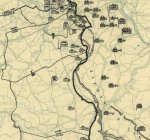
The allocation of those divisions, however, was unbalanced. the VII and V Corps, with eight divisions covered 50 km of frontage (36% of the First US Army's frontage), while VIII Corps with 4 divisions held 64% of the total FUSA frontage. In other words, 1/3 of the FUSA forces held almost 2/3 of FUSA's frontage. I blame Hodges for that. If you stick your head into the hornet's nest once, you should say to yourself, "Dang. That was painful. Let's go somewhere else."
Not only that, but the strength on the other side was equally unbalanced by being concentrated in/around the Hürtgen. Hodges simply lacked common sense. Even when he visited the front and saw the terrain and carnage, he blamed his officers, threatened them and committed even more troops to mayhem...I have been thinking about this. The First Army held around 140 km of frontage. It had three corps (VII, V, and VIII) with twelve divisions.
View attachment 4885
The allocation of those divisions, however, was unbalanced. the VII and V Corps, with eight divisions covered 50 km of frontage (36% of the First US Army's frontage), while VIII Corps with 4 divisions held 64% of the total FUSA frontage. In other words, 1/3 of the FUSA forces held almost 2/3 of FUSA's frontage. I blame Hodges for that. If you stick your head into the hornet's nest once, you should say to yourself, "Dang. That was painful. Let's go somewhere else."
November 16, 1944: Operation Queen commences with one of the heaviest Allied tactical bombings of the war - between 11:13 and 12:48, Allied bombers conduct the preliminary bombings (the ground offensive was to begin immediately after the air raids, allowing the defenders no time to re-establish fortifications, supply routes and communications). 1,204 heavy bombers of the U.S. 8th Air Force hit Eschweiler, Weisweiler and Langerwehe with 4,120 bombs, while 339 fighter bombers of the U.S. 9th Air Force attack Hamich, Hurtgen and Gey with 200 tons of bombs. At the same time, 467 Handley Page Halifax and Avro Lancaster heavy bombers attack Düren and Jülich; 180 British bombers hit Heinsberg - in total over 3,000 aircraft of the British RAF and US 8th Air Force drop 10,000 tons of bombs on the German Siegfried defenses in the Hurtgen Forest. The result of the bombing is mixed - the German towns hit suffer from severe destruction. German communications after the bombing are heavily impaired, and there is a considerable effect on the morale, especially on units consisting of more younger and inexperienced troops. However, the direct damage dealt to the German frontline troops is low, and casualties are few. Allied air commanders admit that the bombing did not measure up to expectations. About 12 aircraft are shot down during the initial bombing by meager anti-aircraft fire.
The operation - aimed against the Rur River, as a staging point for a subsequent thrust over the river to the Rhine into Germany - is conducted by the 1st and 9th U.S. Armies. The US 1st Army attacks toward Duren, east of Aachen. To the left, the US 9th Army advances toward Geilenkirchen and Eschweiler with the objective of reaching the Roer River. The two infantry regiments attack in parallel columns: the 8th along the northern edge of the forest towards Düren, the 22nd further south in parallel. The open flanks invite infiltration. Similar tactics elsewhere in Hurtgen "invited disaster". Attacks by the 8th Infantry Regiment on Rother Weh Creek hit heavy resistance and are repulsed with heavy losses. The 22nd fails to take Raven′s Hedge (Rabenheck), beaten back by heavy machine-gun and artillery fire along the firebreaks. After three days, there were 300 losses, including officers and NCOs.
Further north, British 2nd Army captures Meijel unopposed and reaches Zig canal. US 3rd Army continues attacking around Metz, US 7th Army attacks Barbas and Nonhigny and the French 1st Army is attacking around Ste Marie, Montbeliard, and Roches-les-Blamont.
With sufficient ports now usable by the Allies in Europe, the Red Ball Express was shut down. The Red Ball Express was an enormous truck convoy system that supplied Allied forces moving quickly through Europe after breaking out from the D-Day beaches in Normandy in 1944. The route, marked with red balls, was closed to civilian traffic; the trucks were marked with the same red balls and also given priority on regular roads.
On the eastern front, the 46th Army of Soviet 2nd Ukrainian Front again unsuccessfully attacking across the Danube at Csepel Island.
In Italy, British 8th Army pauses for regrouping along the Montone River and Cosina River while US 5th Army does the same. US 12th Air Force aircraft provide ground support and attack transportation targets in the Po valley and at the Brenner Pass.
Pictured: Heavy bombers support US Army’s attack into Germany - vertical aerial photograph showing six Handley Page Halifaxes flying over the blazing target area during a daylight attack on a rail centre north of the River Rhine, November 16, 1944.; The ruins of Düren, 97% of which was destroyed on November 16th as part of the massive bombing campaign of Operation Queen. Duren had 6,431 houses before the assault, and only 131 after. There is no building in Duren today which dates from before 1945.; An M12 155 mm gun shoots against a German bunker in Grossenich, the November 16, 1944.; GIs liberating wine from French civilians after liberating the village.
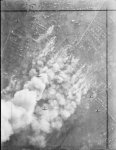
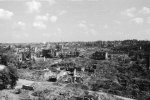
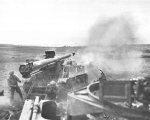
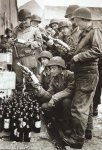
The operation - aimed against the Rur River, as a staging point for a subsequent thrust over the river to the Rhine into Germany - is conducted by the 1st and 9th U.S. Armies. The US 1st Army attacks toward Duren, east of Aachen. To the left, the US 9th Army advances toward Geilenkirchen and Eschweiler with the objective of reaching the Roer River. The two infantry regiments attack in parallel columns: the 8th along the northern edge of the forest towards Düren, the 22nd further south in parallel. The open flanks invite infiltration. Similar tactics elsewhere in Hurtgen "invited disaster". Attacks by the 8th Infantry Regiment on Rother Weh Creek hit heavy resistance and are repulsed with heavy losses. The 22nd fails to take Raven′s Hedge (Rabenheck), beaten back by heavy machine-gun and artillery fire along the firebreaks. After three days, there were 300 losses, including officers and NCOs.
Further north, British 2nd Army captures Meijel unopposed and reaches Zig canal. US 3rd Army continues attacking around Metz, US 7th Army attacks Barbas and Nonhigny and the French 1st Army is attacking around Ste Marie, Montbeliard, and Roches-les-Blamont.
With sufficient ports now usable by the Allies in Europe, the Red Ball Express was shut down. The Red Ball Express was an enormous truck convoy system that supplied Allied forces moving quickly through Europe after breaking out from the D-Day beaches in Normandy in 1944. The route, marked with red balls, was closed to civilian traffic; the trucks were marked with the same red balls and also given priority on regular roads.
On the eastern front, the 46th Army of Soviet 2nd Ukrainian Front again unsuccessfully attacking across the Danube at Csepel Island.
In Italy, British 8th Army pauses for regrouping along the Montone River and Cosina River while US 5th Army does the same. US 12th Air Force aircraft provide ground support and attack transportation targets in the Po valley and at the Brenner Pass.
Pictured: Heavy bombers support US Army’s attack into Germany - vertical aerial photograph showing six Handley Page Halifaxes flying over the blazing target area during a daylight attack on a rail centre north of the River Rhine, November 16, 1944.; The ruins of Düren, 97% of which was destroyed on November 16th as part of the massive bombing campaign of Operation Queen. Duren had 6,431 houses before the assault, and only 131 after. There is no building in Duren today which dates from before 1945.; An M12 155 mm gun shoots against a German bunker in Grossenich, the November 16, 1944.; GIs liberating wine from French civilians after liberating the village.




This strikes me as a result of the logistics difficulties the Red Army faced.November 16, 1944: ... On the eastern front, the 46th Army of Soviet 2nd Ukrainian Front again unsuccessfully attacking across the Danube at Csepel Island.
The Germans had fallen back really quickly over the summer of 1944 and I suspect the Russians had difficulty getting rail lines open and thus had trouble giving smaller offensive ops the "umph" to get across the Danube. Again, offensive culmination.
The Wehrmacht was not very strong by this stage of the war, but strong enough locally to stop an over-extended Red Army at least temporarily.
Supplying modern mechanized warfare requires trainloads of logistics, especially ammo and fuel.
November 17, 1944: Operation Queen in the Hurtgen continues - from 1st Army alone, 694 guns in an hour-long attack fire approximately 45,000 light rounds, almost 4,000 medium, and 2,600 heavy. In addition, hundreds of tank guns, 81-mm. and 4.2-inch mortars, plus a battalion of 4.5-inch rocket projectors contribute to the barrage. On the 9th Army front, another 552 field artillery pieces participate, raising the total in the two armies to 1,246. Despite the massive shelling, it begins to look less and less as if the mammoth preliminary bombardment has sufficiently broken the German forces will or necessary equipment. Just after daylight a platoon of tanks from the attached 745th Tank Battalion move to join Colonel Driscoll's infantry at Hamich, and in the afternoon tanks and infantry attack. By this time, however, the task of fighting the enemy overnight while trying to get into Hamich without tank support has depleted his forces - the day before there were about 160 men per rifle company; now, one company was down to a hundred men and the other two down to 60 or 70 each. About 70 percent of the casualties, Colonel Driscoll estimated, were from enemy shellfire, the rest from small arms fire. Neither tanks nor infantry could get into Hamich.
Soon after it becomes evident that this is the big Allied attack the Germans thought was coming, General von Zangen (new commander of the Fifteenth Army (alias Gruppe von Manteuffel)), cancels the impending relief of the 12th Division. Though Zangen had ordered artillery of the incoming 47th Volks Grenadier Division to reinforce the attack of the 12th Division's artillery, he directs that the 47th Division's other troops assemble as an LXXXI Corps reserve. A small combat team of the 116th Panzer Division, moving north from Hurtgen, is to strengthen the corps reserve. These are the only immediate German orders at an army level directly affecting the sector opposite the 1st Division.
Throughout the day, Operation Queen proceeds as planned, though the Garman’s fight back fiercely and allow little progress: the US 9th Army attacks around Immendorf, Puffendorf, Apweiler, Siersdorf, Bettendorf, Heengen, Wuerselen, and Broichweiden and US 1st Army attacks around Donnerberg, Birkengang, Hastenrath, Scherpenseel, Eschweiler woods, Gressenich, and Hamich.
US 3rd Army continues its attacks in Metz and around Hackenberg, Klang, Metzeresche, Sansonnet, Frescaty airfield, Fort Queuleu, and Frontigny, while the US 7th Army captures Avricourt, Badonviller, St Die, and Corcieux and the French 1st Army driving against Belfort.
In Italy, the British 8th Army continues attacking Monte Fortino while US 12th Air Force aircraft provide ground support and attack transportation targets in the Po valley and at the Brenner Pass. US Navy destroyers Woolsey and Benson bombard German positions around Ventimiglia.
Pictured: The starkness of the Hurtgen Forest as the battle began to rage on November 17, 1944.; Sherman tanks mounted with 105mm. howitzers open fire in a muddy field amid the Hurtgen Forest on November 17, 1944.; Men of the 378th Infantry are shown on the morning of November 17, 1944 entering Metz in pursuit of the enemy along roads strewn with abandoned equipment.; German prisoners captured by 53rd (Welsh) Division in Holland, November 17, 1944.

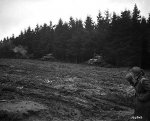
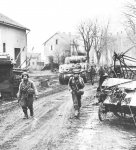
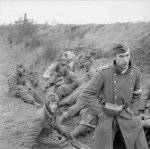
Soon after it becomes evident that this is the big Allied attack the Germans thought was coming, General von Zangen (new commander of the Fifteenth Army (alias Gruppe von Manteuffel)), cancels the impending relief of the 12th Division. Though Zangen had ordered artillery of the incoming 47th Volks Grenadier Division to reinforce the attack of the 12th Division's artillery, he directs that the 47th Division's other troops assemble as an LXXXI Corps reserve. A small combat team of the 116th Panzer Division, moving north from Hurtgen, is to strengthen the corps reserve. These are the only immediate German orders at an army level directly affecting the sector opposite the 1st Division.
Throughout the day, Operation Queen proceeds as planned, though the Garman’s fight back fiercely and allow little progress: the US 9th Army attacks around Immendorf, Puffendorf, Apweiler, Siersdorf, Bettendorf, Heengen, Wuerselen, and Broichweiden and US 1st Army attacks around Donnerberg, Birkengang, Hastenrath, Scherpenseel, Eschweiler woods, Gressenich, and Hamich.
US 3rd Army continues its attacks in Metz and around Hackenberg, Klang, Metzeresche, Sansonnet, Frescaty airfield, Fort Queuleu, and Frontigny, while the US 7th Army captures Avricourt, Badonviller, St Die, and Corcieux and the French 1st Army driving against Belfort.
In Italy, the British 8th Army continues attacking Monte Fortino while US 12th Air Force aircraft provide ground support and attack transportation targets in the Po valley and at the Brenner Pass. US Navy destroyers Woolsey and Benson bombard German positions around Ventimiglia.
Pictured: The starkness of the Hurtgen Forest as the battle began to rage on November 17, 1944.; Sherman tanks mounted with 105mm. howitzers open fire in a muddy field amid the Hurtgen Forest on November 17, 1944.; Men of the 378th Infantry are shown on the morning of November 17, 1944 entering Metz in pursuit of the enemy along roads strewn with abandoned equipment.; German prisoners captured by 53rd (Welsh) Division in Holland, November 17, 1944.




Military writer James Dunnigan in his book How to Make War, wrote: "Artillery did most of the killing and infantry did most of the dying."November 17, 1944: ...By this time, however, the task of fighting the enemy overnight while trying to get into Hamich without tank support has depleted his forces - the day before there were about 160 men per rifle company; now, one company was down to a hundred men and the other two down to 60 or 70 each. About 70 percent of the casualties, Colonel Driscoll estimated, were from enemy shellfire, the rest from small arms fire.
I guess that was true.
This seemed to be peculiarly true in the Hürtgen, where the Germans had the field of view and had the GIs dialed in, when the reverse wasn't true...Military writer James Dunnigan in his book How to Make War, wrote: "Artillery did most of the killing and infantry did most of the dying."
I guess that was true.
There is a thing in artillery tactics called "registering." You shoot a cannon at a spot, and the Forward Observer (FO) adjusts the impact of the rounds until the cannon can hit the spot consistently. Then, the Fire Direction Center write those data down (i.e. the deflection, elevation and charge and what type of target that target was).This seemed to be peculiarly true in the Hürtgen, where the Germans had the field of view and had the GIs dialed in, when the reverse wasn't true...
As long as you don't move the cannon (and have to reset the baseplate, to borrow a mortar analogy), then it is just a matter of dialing up the old deflection, elevation and charge and you can be very accurate with the first round, which is important since the round is supersonic and the men on the target cannot hear the round coming until it explodes in their midst (i.e. before they can dive for cover). Artillery that is "first round accurate" is deadly to opposing infantry. This makes artillery in the tactical defense quite deadly because the defenders can register their artillery before the fight begins.
Last edited:
November 18, 1944: Day 3 of Operation Queen - the bloody battle for the Hurtgen. Tanks are now deemed essential, so engineers blasted tank routes through the forest. Communications and logistics remain a problem, so the next day the attack pauses to allow re-supply and evacuation of the wounded. German reinforcements arrive from 344th and 353rd Infantry Divisions and resistance stiffens further.
The 4th Division's 8th Regiment is next to go in - the regiment is given a ruined monastery a mile and a half into the forest beyond Schevenhütte as an objective. To reach the site, the soldiers have to pass through a thick belt of enemy mines and defensive positions. Air support and artillery have failed to eliminate the well-dug-in defenders, so when the 2nd Battalion of the 8th heads out, it enters a carpet of mines in front of an extensive wall of barbed wire. The first attacks cut down every rifle company commander, along with most of the platoon leaders and senior noncoms. A second attempt, begun with the addition of tanks, is expected to carve a path through the minefield and help breach the concertina wire, but mud and a deep slope bog down four of the five tanks. The remaining one does carve a pathway through the minefield, though it is unable to penetrate the wire.
Major George Mabry, who had received a Distinguished Service Cross (DSC) in recognition of his D-Day exploits, assumes command of the battalion, which even with 200 replacements still amounts to only 60 percent of the normal complement. Mabry personally reconnoiters the terrain, then leads an attack. The major notices indentations in the snow, which he reasons indicate mine locations. He digs some out with his trench knife to makes a safe passage. Mabry himself rushes several bunkers with a small group of soldiers, and his troops gain their objective. He receives the Medal of Honor for his valor.
Mabry's official Medal of Honor citation reads:
He was commanding the 2d Battalion, 8th Infantry, in an attack through the Hurtgen Forest near Schevenhutte, Germany, on 20 November 1944. During the early phases of the assault, the leading elements of his battalion were halted by a minefield and immobilized by heavy hostile fire. Advancing alone into the mined area, Col. Mabry established a safe route of passage. He then moved ahead of the foremost scouts, personally leading the attack, until confronted by a boobytrapped double concertina obstacle. With the assistance of the scouts, he disconnected the explosives and cut a path through the wire. Upon moving through the opening, he observed 3 enemy in foxholes whom he captured at bayonet point. Driving steadily forward he paced the assault against 3 log bunkers which housed mutually supported automatic weapons. Racing up a slope ahead of his men, he found the initial bunker deserted, then pushed on to the second where he was suddenly confronted by 9 onrushing enemy. Using the butt of his rifle, he felled 1 adversary and bayoneted a second, before his scouts came to his aid and assisted him in overcoming the others in hand-to-hand combat. Accompanied by the riflemen, he charged the third bunker under pointblank small arms fire and led the way into the fortification from which he prodded 6 enemy at bayonet point. Following the consolidation of this area, he led his battalion across 300 yards of fire-swept terrain to seize elevated ground upon which he established a defensive position which menaced the enemy on both flanks, and provided his regiment a firm foothold on the approach to the Cologne Plain. Col. Mabry's superlative courage, daring, and leadership in an operation of major importance exemplify the finest characteristics of the military service.
Around Aachen, the ritish 30th Corps (part of British 2nd Army) coordinates assaults with the US 9th and 1st Armies as part of Operation Clipper (http://en.wikipedia.org/wiki/Operation_Clipper), attacking toward Geilenkirchen and capturing Tripsrath and Prummern. Julich and Duren are penetrated. Meanwhile, US 3rd Army advances and approaches the German border. Bouzonville on the Nied River is captured. Metz is entered from north and south by US XX Corps. US 7th Army attacks around Fremonville and Raon-l'Etape
Over Germany, US 8th Air Force fighters attack airfields and other targets, claiming 14 Me-262 jets destroyed on the ground, US 15th Air Force attacks Vienna and RAF Bomber Command sends 479 aircraft to attack Munster during the day, 285 aircraft to attack Wanne-Eickel overnight, and 21 aircraft to attack Hannover overnight.
On the eastern front, the Soviet 8th Army opens an attack against German positions on Sworbe peninsula of Oesel (Saaremaa) Island with strong air support. the 46th Army of Soviet 2nd Ukrainian Front unsuccessfully attacks across the Danube at Csepel Island.
In Italy, the US 5th and British 8th Armies spend the day regrouping while US 12th Air Force aircraft attack transportation lines and other targets throughout the northern Appenines and Po valley and US 15th Air Force attacks airfields in northern Italy.
Pictured: Medal of Honor recipient George L. Mabry, Jr. Mabry was also a awarded the Distinguished Service Cross, Distinguished Service Medal, Silver Star, Legion of Merit, Bronze Star and Purple Heart.; GIs of the U.S. 5th Infantry Division enter Metz on November 18, 1944.; US Army Pfc. Carl Anker, Pfc. Edmund Dill, and Sgt. Ted Bailey sharing the contents of the care package sent by Dill's wife for the Christmas holiday, November 18, 1944.; An SAS Willys MB Jeep 4x4 manned by Sergeant Schofield and Trooper Jeavons of 1st SAS near Geilenkirchen, Germany: November, 18 1944. The jeep is armed with three Vickers 'K' guns, and fitted with armored glass shields in place of a windscreen. The SAS were involved at this time in clearing snipers in the 43rd Wessex Division area.
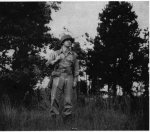
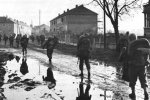
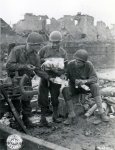
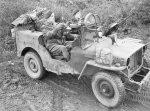
The 4th Division's 8th Regiment is next to go in - the regiment is given a ruined monastery a mile and a half into the forest beyond Schevenhütte as an objective. To reach the site, the soldiers have to pass through a thick belt of enemy mines and defensive positions. Air support and artillery have failed to eliminate the well-dug-in defenders, so when the 2nd Battalion of the 8th heads out, it enters a carpet of mines in front of an extensive wall of barbed wire. The first attacks cut down every rifle company commander, along with most of the platoon leaders and senior noncoms. A second attempt, begun with the addition of tanks, is expected to carve a path through the minefield and help breach the concertina wire, but mud and a deep slope bog down four of the five tanks. The remaining one does carve a pathway through the minefield, though it is unable to penetrate the wire.
Major George Mabry, who had received a Distinguished Service Cross (DSC) in recognition of his D-Day exploits, assumes command of the battalion, which even with 200 replacements still amounts to only 60 percent of the normal complement. Mabry personally reconnoiters the terrain, then leads an attack. The major notices indentations in the snow, which he reasons indicate mine locations. He digs some out with his trench knife to makes a safe passage. Mabry himself rushes several bunkers with a small group of soldiers, and his troops gain their objective. He receives the Medal of Honor for his valor.
Mabry's official Medal of Honor citation reads:
He was commanding the 2d Battalion, 8th Infantry, in an attack through the Hurtgen Forest near Schevenhutte, Germany, on 20 November 1944. During the early phases of the assault, the leading elements of his battalion were halted by a minefield and immobilized by heavy hostile fire. Advancing alone into the mined area, Col. Mabry established a safe route of passage. He then moved ahead of the foremost scouts, personally leading the attack, until confronted by a boobytrapped double concertina obstacle. With the assistance of the scouts, he disconnected the explosives and cut a path through the wire. Upon moving through the opening, he observed 3 enemy in foxholes whom he captured at bayonet point. Driving steadily forward he paced the assault against 3 log bunkers which housed mutually supported automatic weapons. Racing up a slope ahead of his men, he found the initial bunker deserted, then pushed on to the second where he was suddenly confronted by 9 onrushing enemy. Using the butt of his rifle, he felled 1 adversary and bayoneted a second, before his scouts came to his aid and assisted him in overcoming the others in hand-to-hand combat. Accompanied by the riflemen, he charged the third bunker under pointblank small arms fire and led the way into the fortification from which he prodded 6 enemy at bayonet point. Following the consolidation of this area, he led his battalion across 300 yards of fire-swept terrain to seize elevated ground upon which he established a defensive position which menaced the enemy on both flanks, and provided his regiment a firm foothold on the approach to the Cologne Plain. Col. Mabry's superlative courage, daring, and leadership in an operation of major importance exemplify the finest characteristics of the military service.
Around Aachen, the ritish 30th Corps (part of British 2nd Army) coordinates assaults with the US 9th and 1st Armies as part of Operation Clipper (http://en.wikipedia.org/wiki/Operation_Clipper), attacking toward Geilenkirchen and capturing Tripsrath and Prummern. Julich and Duren are penetrated. Meanwhile, US 3rd Army advances and approaches the German border. Bouzonville on the Nied River is captured. Metz is entered from north and south by US XX Corps. US 7th Army attacks around Fremonville and Raon-l'Etape
Over Germany, US 8th Air Force fighters attack airfields and other targets, claiming 14 Me-262 jets destroyed on the ground, US 15th Air Force attacks Vienna and RAF Bomber Command sends 479 aircraft to attack Munster during the day, 285 aircraft to attack Wanne-Eickel overnight, and 21 aircraft to attack Hannover overnight.
On the eastern front, the Soviet 8th Army opens an attack against German positions on Sworbe peninsula of Oesel (Saaremaa) Island with strong air support. the 46th Army of Soviet 2nd Ukrainian Front unsuccessfully attacks across the Danube at Csepel Island.
In Italy, the US 5th and British 8th Armies spend the day regrouping while US 12th Air Force aircraft attack transportation lines and other targets throughout the northern Appenines and Po valley and US 15th Air Force attacks airfields in northern Italy.
Pictured: Medal of Honor recipient George L. Mabry, Jr. Mabry was also a awarded the Distinguished Service Cross, Distinguished Service Medal, Silver Star, Legion of Merit, Bronze Star and Purple Heart.; GIs of the U.S. 5th Infantry Division enter Metz on November 18, 1944.; US Army Pfc. Carl Anker, Pfc. Edmund Dill, and Sgt. Ted Bailey sharing the contents of the care package sent by Dill's wife for the Christmas holiday, November 18, 1944.; An SAS Willys MB Jeep 4x4 manned by Sergeant Schofield and Trooper Jeavons of 1st SAS near Geilenkirchen, Germany: November, 18 1944. The jeep is armed with three Vickers 'K' guns, and fitted with armored glass shields in place of a windscreen. The SAS were involved at this time in clearing snipers in the 43rd Wessex Division area.




More incentive to cease ops here and shift emphasis elsewhere (unless things are going swimmingly, which they were not.November 18, 1944: ... German reinforcements arrive from 344th and 353rd Infantry Divisions and resistance stiffens further.
Operational art (Оперативное изкуство in the terms of the man who first presented it, Soviet military thinker Alexander Svechin) is the arrangement of battles and engagements in time, space, combat power, and purpose.
I guess sometimes the decision-maker just gets stubborn and keeps pushing at a place that is not objectively that important, but becomes a test of wills with the other commander. Hitler at Stalingrad would be a case in point. Der Fuhrer just wanted that city because of its name and saw the contest as a test of wills between him and Stalin. It was stupid from the German perspective since the Wehrmacht could have achieved its strategic objectives without prying the Soviets out of the city.
Courtney Hodges was just being stubborn here in the Huertgen when flexibility and agility (pushing elsewhere) would have saved his soldiers' lives and paid 1st Army greater operational dividends.
Last edited:
November 19, 1944: It’s Sunday, day four of Operation Queen, and the Allied progression continues, though slow and extremely violent. Allied forces advance all along the line. Forces of US 9th Army defeat a counterattack by German forces and occupy Geilenkirchen, north of Aachen while continuing to attack around Freialdenhoven, Setterich, Duerboslar, Schleiden, St Joeris, and Kinzweiler.
Company H, 26th Infantry Regiment, 1st Infantry Division pushes forward through the dense forest (near Schevenhütte, Germany) when they are hit by a fierce German counterattack. 26-year-old Private First Class Francis McGraw single-handedly slows down the counterattack until it can be repulsed by the 26th IR. He is posthumously awarded the Medal of Honor for his actions - the official Medal of Honor citation reads:
“He manned a heavy machine gun in a foxhole near Schevenhutte, Germany, on 19 November 1944, when the enemy launched a fierce counterattack. Braving an intense hour-long preparatory barrage, he maintained his stand and poured deadly accurate fire into the advancing foot troops, until they faltered and came to a halt. The hostile forces brought up a machine gun in an effort to dislodge him but were frustrated when he lifted his gun to an exposed but advantageous position atop a log, courageously stood up in his foxhole and knocked out the enemy weapon. A rocket blasted his gun from position, but he retrieved it and continued firing. He silenced a second machine gun and then made repeated trips over fire-swept terrain to replenish his ammunition supply. Wounded painfully in this dangerous task, he disregarded his injury and hurried back to his post, where his weapon was showered with mud when another rocket barely missed him. In the midst of the battle, with enemy troops taking advantage of his predicament to press forward, he calmly cleaned his gun, put it back into action and drove off the attackers. He continued to fire until his ammunition was expended, when, with a fierce desire to close with the enemy, he picked up a carbine, killed 1 enemy soldier, wounded another and engaged in a desperate firefight with a third until he was mortally wounded by a burst from a machine pistol. The extraordinary heroism and intrepidity displayed by Pvt. McGraw inspired his comrades to great efforts and was a major factor in repulsing the enemy attack.”
US 3rd Army completes the encirclement of Metz (now completely cut off from supplies and reinforcements) and the US 95th Division forces its way in, fighting street to street to eradicate the enemy. Farther south, French 1st Army forces reach the outskirts of Belfort as well as the Swiss border north of Basle and the French 1st Armored Division reaches the Rhine River near Strasbourg, France. British 2nd Army attacking around Prummern, Wurm, Helden, and Panningen and captures Geilenkirchen and the US 7th Army makes substantial gains and pushes toward Saverne Gap. British 12th and 7th Corps (parts of British 2nd Army) gain ground near Venlo.
In Italy, the US 12th Air Force conducts limited ground support missions and attacks on transportation targets in poor weather conditions while the US 15th Air Force attacks transportation targets in northern Italy.
In Washington, it is estimated that the cost of the war is now about $250 million per day. Looking for ways to fund World War II, President Franklin D. Roosevelt announced the 6th War Loan Drive on this day. The Loan Drive flooded the market with war bonds intended to meet Roosevelt's goals of "immediately" raising $14 billion for the war.
Pictured: An M8 75mm HMC of the 82nd Armored Recc Battalion, 2nd Armored Division leads a column through Setterich during the battle with the German 9th Panzer Division.; Medal of Honor recipient Francis McGraw’s burial marker at the Henri-Chapelle American Cemetery and Memorial in Liège, Belgium.; Troops of 5th Infantry Division conducting a house-to-house search in Metz on November 19, 1944.; The ordeal of the wounded in the ‘Bloody Forest’ of Hurtgen. The struggle to bring up ammunition in the Hurtgen Forest, extricating the wounded was even more difficult, November 19, 1944.

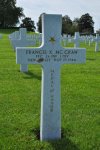

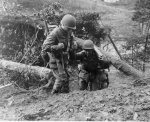
Company H, 26th Infantry Regiment, 1st Infantry Division pushes forward through the dense forest (near Schevenhütte, Germany) when they are hit by a fierce German counterattack. 26-year-old Private First Class Francis McGraw single-handedly slows down the counterattack until it can be repulsed by the 26th IR. He is posthumously awarded the Medal of Honor for his actions - the official Medal of Honor citation reads:
“He manned a heavy machine gun in a foxhole near Schevenhutte, Germany, on 19 November 1944, when the enemy launched a fierce counterattack. Braving an intense hour-long preparatory barrage, he maintained his stand and poured deadly accurate fire into the advancing foot troops, until they faltered and came to a halt. The hostile forces brought up a machine gun in an effort to dislodge him but were frustrated when he lifted his gun to an exposed but advantageous position atop a log, courageously stood up in his foxhole and knocked out the enemy weapon. A rocket blasted his gun from position, but he retrieved it and continued firing. He silenced a second machine gun and then made repeated trips over fire-swept terrain to replenish his ammunition supply. Wounded painfully in this dangerous task, he disregarded his injury and hurried back to his post, where his weapon was showered with mud when another rocket barely missed him. In the midst of the battle, with enemy troops taking advantage of his predicament to press forward, he calmly cleaned his gun, put it back into action and drove off the attackers. He continued to fire until his ammunition was expended, when, with a fierce desire to close with the enemy, he picked up a carbine, killed 1 enemy soldier, wounded another and engaged in a desperate firefight with a third until he was mortally wounded by a burst from a machine pistol. The extraordinary heroism and intrepidity displayed by Pvt. McGraw inspired his comrades to great efforts and was a major factor in repulsing the enemy attack.”
US 3rd Army completes the encirclement of Metz (now completely cut off from supplies and reinforcements) and the US 95th Division forces its way in, fighting street to street to eradicate the enemy. Farther south, French 1st Army forces reach the outskirts of Belfort as well as the Swiss border north of Basle and the French 1st Armored Division reaches the Rhine River near Strasbourg, France. British 2nd Army attacking around Prummern, Wurm, Helden, and Panningen and captures Geilenkirchen and the US 7th Army makes substantial gains and pushes toward Saverne Gap. British 12th and 7th Corps (parts of British 2nd Army) gain ground near Venlo.
In Italy, the US 12th Air Force conducts limited ground support missions and attacks on transportation targets in poor weather conditions while the US 15th Air Force attacks transportation targets in northern Italy.
In Washington, it is estimated that the cost of the war is now about $250 million per day. Looking for ways to fund World War II, President Franklin D. Roosevelt announced the 6th War Loan Drive on this day. The Loan Drive flooded the market with war bonds intended to meet Roosevelt's goals of "immediately" raising $14 billion for the war.
Pictured: An M8 75mm HMC of the 82nd Armored Recc Battalion, 2nd Armored Division leads a column through Setterich during the battle with the German 9th Panzer Division.; Medal of Honor recipient Francis McGraw’s burial marker at the Henri-Chapelle American Cemetery and Memorial in Liège, Belgium.; Troops of 5th Infantry Division conducting a house-to-house search in Metz on November 19, 1944.; The ordeal of the wounded in the ‘Bloody Forest’ of Hurtgen. The struggle to bring up ammunition in the Hurtgen Forest, extricating the wounded was even more difficult, November 19, 1944.




Last edited:
The more I've read about Hodges, the more he appears to have been a migratory disaster area...More incentive to cease ops here and shift emphasis elsewhere (unless things are going swimmingly, which they were not.
Operational art (Оперативное изкуство in the terms of the man who first presented it, Soviet military thinker Alexander Svechin) is the arrangement of battles and engagements in time, space, combat power, and purpose.
I guess sometimes the decision-maker just gets stubborn and keeps pushing at a place that is not objectively that important, but becomes a test of wills with the other commander. Hitler art Stalingrad would be a case in point. Der Fuhrer just wanted that city because of its name and saw the contest as a test of wills between him and Stalin. It was stupid from the German perspective since the Wehrmacht could have achieved its strategic objectives without prying the Soviets out of the city.
Courtney Hodges was just being stubborn here in the Huertgen when flexibility and agility (pushing elsewhere) would have saved his soldiers' lives and paid 1st Army greater operational dividends.
- Status
- Not open for further replies.
Latest threads
-
US Army replacing 5.56mm rifle with a 6.8mm for infantry
- Started by Tidewater
- Replies: 6
-
-
Game One of Alabama-Texas A&M Alabama Series Moved to Friday as Part of Doubleheader
- Started by Diamond Tide
- Replies: 0
-
Bama Game Thread: Bama Gymnastics - NCAA Championship Semi-finals (ESPN2 | 4/18 @ 8pm CT)
- Started by BamaNation
- Replies: 32
-
No. 1 Visits Tuscaloosa for Second Straight Week as Alabama Hosts Top-Ranked Texas A&M
- Started by Diamond Tide
- Replies: 0
-

